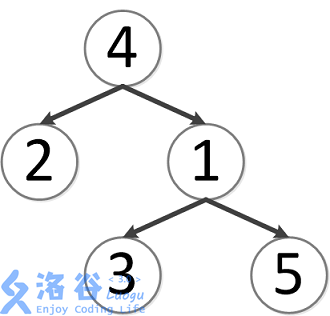洛谷 P3379 【模板】最近公共祖先(LCA)
来源:互联网 发布:抽奖系统数据库设计 编辑:程序博客网 时间:2024/06/05 07:27
题目描述
如题,给定一棵有根多叉树,请求出指定两个点直接最近的公共祖先。
输入输出格式
输入格式:
第一行包含三个正整数N、M、S,分别表示树的结点个数、询问的个数和树根结点的序号。
接下来N-1行每行包含两个正整数x、y,表示x结点和y结点之间有一条直接连接的边(数据保证可以构成树)。
接下来M行每行包含两个正整数a、b,表示询问a结点和b结点的最近公共祖先。
输出格式:
输出包含M行,每行包含一个正整数,依次为每一个询问的结果。
输入输出样例
输入样例#1: 复制
5 5 4
3 1
2 4
5 1
1 4
2 4
3 2
3 5
1 2
4 5
输出样例#1: 复制
4
4
1
4
4
说明
时空限制:1000ms,128M
数据规模:
对于30%的数据:N<=10,M<=10
对于70%的数据:N<=10000,M<=10000
对于100%的数据:N<=500000,M<=500000
样例说明:
该树结构如下:

第一次询问:2、4的最近公共祖先,故为4。
第二次询问:3、2的最近公共祖先,故为4。
第三次询问:3、5的最近公共祖先,故为1。
第四次询问:1、2的最近公共祖先,故为4。
第五次询问:4、5的最近公共祖先,故为4。
故输出依次为4、4、1、4、4。
周六考试,很焦灼,不知道刷什么题好。。。 打打模板。。
//树剖用时仅1044Ms#include<iostream>#include<cstring>#include<cstdio>#include<cctype>#include<algorithm>#define MAXN 520010using namespace std;struct Edge{ int to,next; }e[MAXN << 1];int tot,head[MAXN],fa[MAXN],dep[MAXN],siz[MAXN],son[MAXN],top[MAXN];inline void read(int &x) { x = 0; register char c = getchar(); while(!isdigit(c)) c = getchar(); while(isdigit(c)) x = x * 10 + c - '0',c = getchar();}inline void Add_Edge(int u,int v) { e[++tot].to = v,e[tot].next = head[u],head[u] = tot; e[++tot].to = u,e[tot].next = head[v],head[v] = tot;}void DFS(int u,int ft,int deepth) { fa[u] = ft,dep[u] = deepth,siz[u] = 1,son[u] = 0; for(int i=head[u]; i; i=e[i].next) { int v = e[i].to; if(v == ft) continue; DFS(v,u,deepth + 1); siz[u] += siz[v]; if(!son[u] || siz[son[u]] < siz[v]) son[u] = v; }}void Dfs(int u,int Top) { top[u] = Top; if(son[u]) Dfs(son[u],Top); for(int i=head[u]; i; i=e[i].next) { int v = e[i].to; if(v != son[u] && v != fa[u]) Dfs(v,v); }}int LCA(int u,int v) { while(top[u] != top[v]) if(dep[top[u]] > dep[top[v]]) u = fa[top[u]]; else v = fa[top[v]]; return dep[u] < dep[v] ? u : v;}int main(int argc,char *argv[]) { int n,m,Root,u,v; read(n),read(m),read(Root); for(int i=1; i<=n-1; ++i) read(u),read(v),Add_Edge(u,v); DFS(Root,-1,1); Dfs(Root,Root); for(int i=1; i<=m; ++i) { read(u),read(v); printf("%d\n",LCA(u,v)); } return 0;}//倍增是树剖两倍左右。。#include<iostream>#include<cstring>#include<cstdio>#include<cctype>#include<algorithm>#define MAXN 520010using namespace std;struct Edge{ int to,next; }e[MAXN << 1];int tot,head[MAXN],fa[MAXN][21],dep[MAXN];inline void read(int &x) { x = 0; register char c = getchar(); while(!isdigit(c)) c = getchar(); while(isdigit(c)) x = x * 10 + c - '0',c = getchar();}inline void Add_Edge(int u,int v) { e[++tot].to = v,e[tot].next = head[u],head[u] = tot; e[++tot].to = u,e[tot].next = head[v],head[v] = tot;}void DFS(int u,int ft,int deepth) { fa[u][0] = ft; dep[u] = deepth; for(int i=head[u]; i; i=e[i].next) { int v = e[i].to; if(v == ft) continue; DFS(v,u,deepth + 1); }}int LCA(int u,int v) { if(dep[u] < dep[v]) swap(u,v); for(int j=20; j>=0; --j) if(dep[fa[u][j]] >= dep[v]) u = fa[u][j]; if(u == v) return u; for(int j=20; j>=0; --j) if(fa[u][j] != fa[v][j]) { v = fa[v][j],u = fa[u][j]; } return fa[u][0];}int main(int argc,char *argv[]) { int n,m,Root,u,v; read(n),read(m),read(Root); for(int i=1; i<=n-1; ++i) read(u),read(v),Add_Edge(u,v); DFS(Root,-1,1); for(int j=1; j<=20; ++j) for(int i=1; i<=n; ++i) fa[i][j] = fa[fa[i][j-1]][j-1]; for(int i=1; i<=m; ++i) { read(u),read(v); printf("%d\n",LCA(u,v)); } return 0;}阅读全文
0 0
- P3379 【模板】最近公共祖先(LCA)
- 洛谷 P3379 【模板】最近公共祖先(LCA)
- 洛谷P3379 【模板】最近公共祖先(LCA)
- 洛谷 P3379 【模板】最近公共祖先(LCA)
- 洛谷 P3379 【模板】最近公共祖先(LCA)
- lca(洛谷P3379 最近公共祖先(LCA))
- LCA----【模板】最近公共祖先(LCA)
- 【模板】最近公共祖先(LCA)
- 【模板】最近公共祖先(LCA)
- 【模板】【图论】最近公共祖先(LCA)
- 【模板】最近公共祖先(LCA)
- 洛谷 P 3379 【模板】最近公共祖先(LCA)
- 【洛谷】3379 【模板】最近公共祖先(LCA)
- 洛谷 3379_【模板】最近公共祖先(LCA)
- 最近公共祖先LCA【模板】
- [模板]最近公共祖先LCA
- 【模板】lca 最近公共祖先
- LCA(最近公共祖先)
- easyui 说明(一)
- 进程控制模拟程序
- Activity跳转的过渡动画全解析
- EventBus的两个Activity的传值
- 初识压缩感知Compressive Sensing
- 洛谷 P3379 【模板】最近公共祖先(LCA)
- 关于H5 web页面在ios端滑动卡顿问题
- WebService(2)——使用eclipse的TCP_IP工具监听端口
- ofbiz——集成富文本编辑器ueditor
- 数据结构--哈夫曼树建立及打印编码
- 第二章 第六课 Scratch作品:摇摇晃晃的虫子(随机数和碰到边缘就反弹)
- android:windowSoftInputMode属性详解
- js下如何弹出保存对话框进行文件下载
- Conerstone破解版安装后提示“已损坏”问题


